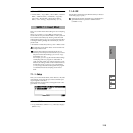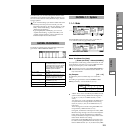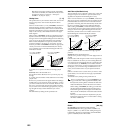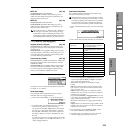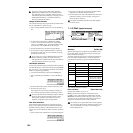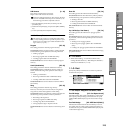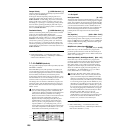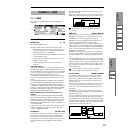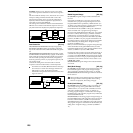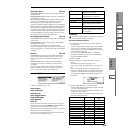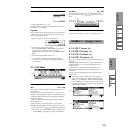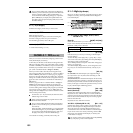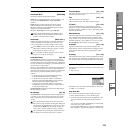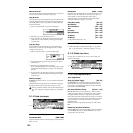
GLOBAL
1.1
2.13.14.15.16.1
GLOBAL
1.1
2.13.14.15.16.1
127
2.1–1: MIDI
Here you can make MIDI-related settings that affect this
instrument.
2.1–1a: MIDI Setup
MIDI Channel [1…16]
Sets the global MIDI channel.
The global MIDI channel is used in the following cases.
•When transmitting and receiving performance data in
Program mode (PROG 1.1: Play) and Sampling mode
(if the EXB-SMPL option is installed).
•When selecting combinations via MIDI in Combination
mode (COMBI 1.1: Play).
•When controlling timbres or effects that have been set
to Gch in various modes
•When transmitting and receiving system exclusive
messages
About MIDI reception
In Program mode (PROG 1.1: Play) and Sampling mode (if
the EXB-SMPL option is installed), MIDI data is received on
the global MIDI channel, but in Combination mode (COMBI
1.1: Play) or Sequencer mode, MIDI data is received on the
MIDI channel specified for each timbre or track.
In Combination mode (COMBI 1.1: Play), program changes
received on the global MIDI channel will switch the combi-
nation.
Use the global MIDI channel to switch IFX , MFX1 and MFX2
on/off. To control the pan following IFX, sends 1/2, MFX 1/2
and MEQ, use the global MIDI channel in Program mode; in
Combination, or Sequencer mode, use the channel specified sep-
arately by “Control Channel” for IFX, MFX1, MFX2, and MEQ.
By setting “Control Channel” to Gch, you can control these
parameters from the global MIDI channel.
MIDI transmission when this instrument’s controllers are
operated
In Program mode and Sampling mode (if the EXB-SMPL
option is installed), this data will be transmitted on the glo-
bal MIDI channel. In Combination mode, data will be trans-
mitted simultaneously on the global MIDI channel and on
the MIDI channels of timbres whose “Status” (COMBI 3.1–1)
is set to EXT or EX2.
In Sequencer mode, musical data will be transmitted on the
channel specified for the currently selected track (whose
“Status” is BTH, EXT, or EX2).
Note Receive [All, Even, Odd]
This setting specifies which of the note messages played on
this instrument’s keyboard or received via MIDI will be
sounded. If you connect another TRITON Le unit to this
instrument in order to increase the total polyphony, set one
unit to Even and the other to Odd, and set both units to
sound.
All: All note numbers will be received. Normally you will
leave this set to All.
Even: Even-numbered notes (C, D, E, F#, G#, A#) will sound.
Odd: Odd-numbered notes (C#, D#, F, G, A, B) will sound.
This setting has no effect on the MIDI data that is
received.
MIDI Clock [Internal, External]
Set this parameter when you wish to synchronize an exter-
nal MIDI device (sequencer or rhythm machine etc.) with
the TRITON Le’s internal arpeggiator or sequencer.
Internal: The internal arpeggiator and sequencer will syn-
chronize to the TRITON Le’s own internal clock.
Select the Internal setting when using the TRITON Le by
itself, or when you want the TRITON Le to be the master
(controlling device) so that another connected external MIDI
device will synchronize to the MIDI Clock messages trans-
mitted from the TRITON Le.
External: The arpeggiator and sequencer of the TRITON Le
will synchronize to MIDI Clock messages transmitted from
an external MIDI device connected to the MIDI IN connec-
tor.
Use the External setting when you are using this instrument
as a slave (controlled device) that synchronizes to the MIDI
Clock messages received from an external MIDI device. This
instrument will respond to MIDI real-time messages (Start,
Stop, Continue, Song Select, Song Position Pointer) from an
external sequencer.
Audition playback will occur at the pre-specified
tempo, regardless of the “MIDI Clock” setting.
Convert Position [PreMIDI, PostMIDI]
This setting specifies the location at which the Transpose,
Velocity Curve, and After Touch Curve settings will be
applied. This setting will affect the MIDI data that is trans-
mitted and received, and the data that is recorded on the
internal sequencer.
When using this instrument’s keyboard to play the internal
tone generator, the Transpose, Velocity Curve, and After
Touch Curve settings will always take effect regardless of
this setting.
PreMIDI: Velocity Curve, After Touch Curve, and Trans-
pose will be applied to the data that is transmitted from this
instrument’s keyboard.
This means that the Velocity Curve, After Touch Curve, and
Transpose settings will affect the data that is transmitted
from MIDI OUT when this instrument’s keyboard is played,
and the data that is recorded on the internal sequencer. MIDI
data received from MIDI IN or the data played back by the
internal sequencer will not be affected.
GLOBAL 2.1: MIDI
2.1–1a
2.1–1c2.1–1b
ODD
EVEN
Another TRITON Le
MIDI OUT
MIDI IN
Velocity
Curve
Aftertouch
Curve
Tone
generator
Note number
change
Play
MIDI IN
MIDI OUT
Record
Sequencer
Transpose
Scale



